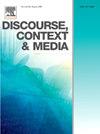Recontextualizing a healthy lifestyle through interface design: A Multimodal Critical Discourse Analysis of the Lifesum app
IF 3.1
2区 文学
Q1 COMMUNICATION
引用次数: 0
Abstract
Self-tracking technologies have created new conditions for self-management and self-control. Research has shown how these technologies and their design are shaped by ideological assumptions and norms, particularly in their interactions with users. However, less attention has been given to the interplay between interface design, user interaction, and meaning making, especially in the context of food and health. This article uses multimodal critical discourse analysis to explore how the interface design of a commercial calorie-tracking app, along with the actions it enables, constructs and reinforces health and healthy eating as scientific practices. It also highlights how healthy eating is framed as something the user must choose, control, adapt, take responsibility for, and improve. Through interface design choices, commercial actors can sustain and reproduce ideas and ideologies linked to nutritionism, wellness and neoliberalism, while simultaneously benefiting from them.
通过界面设计重新定义健康的生活方式:对Lifesum应用程序的多模态批评话语分析
自我跟踪技术为自我管理和自我控制创造了新的条件。研究表明,这些技术及其设计是如何受到意识形态假设和规范的影响的,特别是在它们与用户的互动中。然而,很少有人关注界面设计、用户交互和意义创造之间的相互作用,特别是在食品和健康的背景下。本文使用多模态批判性话语分析来探讨商业卡路里跟踪应用程序的界面设计,以及它支持的行动,构建和加强健康和健康饮食作为科学实践。它还强调了健康饮食是如何被定义为用户必须选择、控制、适应、负责和改进的东西。通过界面设计的选择,商业参与者可以维持和复制与营养主义、健康和新自由主义有关的想法和意识形态,同时从中受益。
本文章由计算机程序翻译,如有差异,请以英文原文为准。
求助全文
约1分钟内获得全文
求助全文

 求助内容:
求助内容: 应助结果提醒方式:
应助结果提醒方式:


